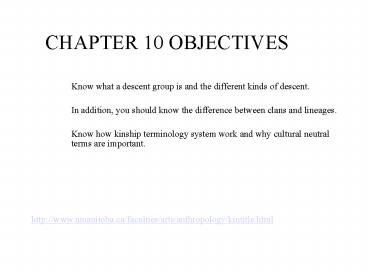CHAPTER 10 OBJECTIVES - PowerPoint PPT Presentation
1 / 12
Title:
CHAPTER 10 OBJECTIVES
Description:
Age within a generation: old sister, younger sister ... Gender of the other: brother - sister ... father's brother different from mother's brother ... – PowerPoint PPT presentation
Number of Views:21
Avg rating:3.0/5.0
Title: CHAPTER 10 OBJECTIVES
1
CHAPTER 10 OBJECTIVES
Know what a descent group is and the different
kinds of descent. In addition, you should know
the difference between clans and lineages. Know
how kinship terminology system work and why
cultural neutral terms are important.
http//www.umanitoba.ca/faculties/arts/anthropolog
y/kintitle.html
2
Tradition Meets Law Families of China
Film
What practices are easier to change and what
practices are more difficult, especially when it
comes to the family? Will women become more
valued as these generations reach marriageable
age? What will happen with the large numbers
of men that will necessarily remain unmarried
unless there are changes to Chinese customs?
3
Descent Groups
- A descent group is a permanent social unit whose
members claim common ancestry. - With matrilineal descent individuals
automatically join the mothers descent group
when they are born. - With patrilineal descent individuals
automatically join the fathers descent group
when they are born.
4
Descent Groups
Cont.
- Matrilineal and patrilineal descent are types of
unilineal descent in which individuals only
recognize one line of descent. - A lineage is a descent group who can demonstrate
their common descent from an apical ancestor. - A clan is a descent group who claims common
descent from an apical ancestor but cannot
demonstrate it (stipulated descent). - When a clans apical ancestor is nonhuman, it is
called a totem.
- http//lucy.ukc.ac.uk/cgi-bin/uncgi/Ethnoatlas/atl
as.vopts
5
Descent Groups
http//www.umanitoba.ca/anthropology/tutor/descent
/unilineal/patri01.html
- Patrilineal descent group.
6
Descent Groups
http//www.umanitoba.ca/anthropology/tutor/descent
/unilineal/matri01.html
- Matrilineal descent group.
7
Lineages, Clans, and Residence Rules
- In tribal societies, the descent group, not the
nuclear family, is the fundamental unit. - In many societies, descent groups are corporate,
sharing resources and property. - Unilocal Residence
- Patrilocalitymarried couple lives with husband's
family associated with patrilineal descent and
is more common than matrilocality. - Matrilocalitymarried couple lives with wife's
family associated with matrilineal descent and
is less common than patrilocality.
8
Kinship Calculation
- Kinship calculation is any systemic method for
reckoning kin relations. - Genealogical Kin Types and Kin Terms
- Kin terms are the labels given in a particular
culture to different kinds of relatives. - Biological kin type refers to the degree of
actual genealogical relatedness.
9
Kinship Analysis
- Generation parents - children
- Age within a generation old sister, younger
sister - Lineal versus collateral father versus uncle
- Gender of the other brother - sister
- Gender of the speaker gender distinction of same
relative - Gender of the speaker who links the speaker with
relative - fathers brother different from mothers
brother - Consanguinal versus affinal marriage versus
blood - Others condition of life alive, dead, single,
married.
http//www.umanitoba.ca/anthropology/tutor/descent
/toc.html
10
Kinship Calculation
- Bilateral Kinship
- Used by most Americans and Canadians.
- Kinship is traced through both male and female
lines. - Kin links through males and females are perceived
as being similar or equivalent. - In North American bilateral kinship there is
often matrilineal skewing, a preference for
relatives on the mother's side.
11
Kinship Terminology
- Kinship terminologies are native taxonomies
(emic), not developed by anthropologists. - Lineal terminology most Americans and Canadians
use lineal terminology, which distinguishes
lineal, collateral, and affinal relatives.
12
The Nuer
Film
- Although one cannot see kinship, what evidences
of kinship are demonstrated in the film? - What does the divorce case suggest about cattle
and social organization? - How are cattle poetic metaphors for the Nuer?































